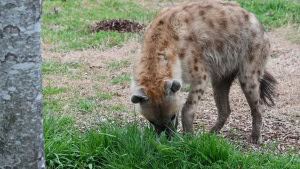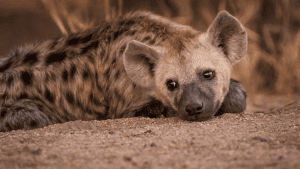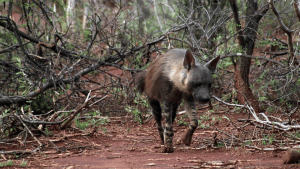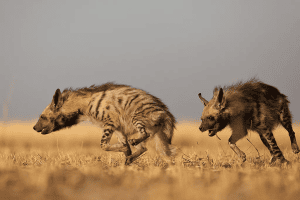Chances are, you’re familiar with the spotted hyena. They are well-known from both The Lion King and nature documentaries. But did you know that they’re not the only hyena?
Hyenas are an unusual-looking animal. Despite their similarities to dogs, they’re actually more closely related to cats. They have longer front legs than hind legs, and all species have a mane. Hyenas also perform the role of the “clean-up crew” of Africa.
The family Hyaenidae is split into two groups, or subfamilies: True hyenas like the spotted, brown and striped hyena; and aardwolves. True hyenas have powerful, bone-crunching jaws and are much larger in size. While spotted hyenas hunt for most of their food, brown and striped hyenas are both scavengers. Aardwolves, on the other hand, are much smaller and eat almost entirely termites.

Spotted Hyena
The spotted hyena is the most well-known species as well as the largest and most social. They are the only hyena with a spotted coat, upright mane and rounded ears. They also live in highly matriarchal societies: Females are larger and more dominant than males, as well as far more aggressive. Cubs are raised by the mother early in life, then later moved to communal dens, where the entire clan will help raise them.
Spotted hyenas have a reputation as scavengers, but this is not very accurate: they actively hunt over 90% of their food. They have incredibly strong jaws which can crush bone, and will consume and digest the bones of its prey. Interestingly, unlike most mammals, spotted hyenas can survive being infected by rabies.

Brown Hyena
The brown hyena is the second-largest member of the hyena family, right after the spotted hyena. With long, shaggy fur and striped legs, they look very different from the image most people think of when they hear the word “hyena.” They also have larger, more pointed ears than the more familiar spotted hyena.
Brown hyenas are native mostly to southern Africa, and either live in small clans or are nomadic. They even have “latrines” in their territory. They scavenge for their food, and all can travel long distances to find it. While traveling, they will often walk in a zig-zag pattern! They can keep themselves hydrated by eating fruit with a high water content.

Striped Hyena
Striped hyenas are smaller than brown hyenas, and have a long mane and stripes all over their body. They are the only species that can be found outside of Africa: they are found in the Middle East and India, and even as far north as southern Siberia! They are the least studied species.
Although usually solitary, in some areas striped hyenas will live in small groups. They scavenge for most of their food, and are known to eat fruit and even insects. While scavenging, they move by trotting in a zig-zag. When they find a carcass, they have to be careful of other predators such as spotted hyenas and lions, who will chase them away. However, they will chase off cheetahs and even leopards.

Aardwolf
Our fourth species of hyena is the aardwolf, which is Afrikaans for “earth wolf.” They are different from the other three in both appearance and diet. They look similar to the striped hyena, but are smaller. They’re also the only hyena that eats insects instead of meat.
Almost all of the aardwolf’s diet is made up of two types of termite: one in the summer and the other in cooler winter months. They don’t dig into and destroy a termite mound; instead, they have a broad, sticky tongue which they use to lap termites off the ground. This allows the termites to replenish their numbers, and aardwolves can come back much later. They can eat 300,000 termites in a single night!
The aardwolf is both solitary and nocturnal, and while we know more about them than we do striped hyenas, they are rarely seen. Ranchers in their area once thought they were predators, and so they would kill them; however, many now know that they eat termites, and will often welcome them as a form of pest control.

Hyenas are fascinating animals, ones that deserve far better than the reputation we have given them. Many people see them as either thieves and scavengers or, in the case of the aardwolf, dangerous predators. However, like all animals, they are just living their lives how they were built: wild.
Sources
Figures 2 – 5: https://blog.nature.org/2022/01/17/did-you-know-there-are-four-hyena-species/
https://blog.nature.org/2022/01/17/did-you-know-there-are-four-hyena-species/
https://animals.sandiegozoo.org/animals/spotted-hyena
https://www.gbif.org/species/113401561
https://animaldiversity.org/accounts/Hyaena_brunnea/
https://treatment.plazi.org/id/03928788FFEDFF812FA7FBEBF8DECE95
https://www.strandwolf.org/namib-hyenas/brown-hyena.html
https://animals.sandiegozoo.org/animals/striped-hyena
https://animaldiversity.org/accounts/Hyaena_hyaena/
https://www.krugerpark.co.za/africa_aardwolf.html
https://animaldiversity.org/accounts/Proteles_cristata/
https://www.newworldencyclopedia.org/entry/Aardwolf
https://wolfcenter.org/misunderstood-mesos-aardwolves/
https://www.ncbi.nlm.nih.gov/pmc/articles/PMC64977/
*Published by Eryn Meeker on 7/13/2024*